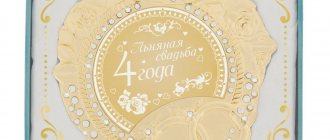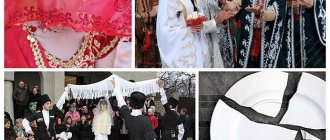Slavic wedding. Customs and traditions of our Ancestors
A wedding is an exciting event for all participants, and a Slavic wedding or even just a wedding in the Slavic style can become an unforgettable, high celebration. Some customs of a Slavic wedding are known to everyone - for example, the wedding train, which used to be called a squad, or the presence of a loaf - a ritual cookie. A well-known ritual of a Slavic wedding is laying an embroidered Slavic towel on the ground, showering the newlyweds with hops and rye “for luck,” and a rich feast. And yet there are Slavic wedding traditions that need to be remembered and explained. This is discussed in the article.
Customs, rituals and traditions of a Slavic wedding
Shortly before the wedding, it was customary to visit the graves of deceased relatives and friends. It was assumed that in this way the future husband and wife received blessings from their ancestors. This action is to feel the relationship with the Family Tree. This is very important for prolongation of the family, when the newlyweds want someone from the family of the husband or wife to be incarnated in their family. Such a close relationship with their ancestors was important for the Slavs of ancient times.
Also, before the wedding itself, it was customary to organize stag and hen parties, which are popular even in modern wedding traditions.
A bachelor party (youth party, or groom’s party) is not so much a tradition as a rite of passage. It could be adhered to either the day before the wedding, or several days before the wedding, which begin from the days of the handshake (betrothal, betrothal, or engagement). The peculiarity of a bachelor party is the ritual feast with peers and friends who are unmarried. This is a farewell to carelessness, single life, festivities and “freedom.” Rituals can be expressed in mysteries - theatrical performances, games with masks on the face, riddles, fairy tales and fun.
A bachelorette party (girl's evening, evening, or bride's party) is a ritual pastime of the bride with her unmarried girlfriends, which takes place either on any day from the day of the marriage, or the day before the wedding itself. This is the time when the bride says goodbye to her girlhood, an easy and simple life, where previously she was not required to have much responsibility and independence. All Russians and Slavs know about the fun and festivities on such a day. However, in the Russian North, a bachelorette party does not begin with fun at all - here you can find crying, lamentations, and poetic regrets. This is how they say goodbye to girlhood and say goodbye to it forever.
Vyunishnik (junins, bypass rite, vyushnik or calling out to the newlyweds) is a bypass rite when the wedding time is marked by congratulations, round dances, glorification, and honoring of the newlyweds who entered into a family union during the current year. This ritual ends the long period of post-wedding time. A Slavic wedding was not a matter of one day, but of a whole period, important for all its participants, and not just for the young. The rite of bindweed or wreath helped newlyweds move from one social status to another, from unmarried to married.
Wedding Slavic rituals
The Slavic wedding ceremony is a whole complex of customs associated with a wedding. It consists of several parts and stretches greatly over time (for several months!). Conventionally, Slavic wedding rituals can be divided into wedding rituals themselves, as well as pre- and post-wedding rituals. There are various, sometimes contradictory, data on how the ancient Slavs held weddings. Different territories had their own peculiarities of the ritual, but in general it remained uniform.
Let's start with the pre-wedding rituals:
- Matchmaking. A guy with two matchmakers went to his beloved's house late in the evening. This time was chosen for a reason. After all, if a guy is rejected, then no one will know about it, since they won’t see anything. The matchmakers entered the house with bread and began a conversation with the owners. Only then they called the girl and asked her consent. Matchmakers should be men, sociable and cheerful, so that they can make the owners laugh and talk.
- Bride. This is the next stage of the wedding ceremony. Now the girl’s family comes to visit the guy. This was done to assess how ready he was to start a family. The young man should already have his own farm.
- Engagement. This is a more serious stage when consent to marriage is confirmed. The groom came to the bride with his family. A rich table was set, the hands of the young people were bandaged with towels. After this stage, the newlyweds were considered engaged. And there was no turning back. Refusal to get married was considered bad manners. In addition, it was necessary to pay for “moral damage” and expenses incurred.
- Baking a loaf. This was a whole ritual that was carried out in the girl’s house. All relatives took part. For the preparation itself, married women were called (there had to be an odd number of them). And, of course, while cooking they sang songs and had fun.
- Bachelorette party and gala evening. This is the so-called farewell party. This is goodbye to your past life. That evening they made wedding wreaths. It was also customary to give gifts, dance and sing.
These are the interesting and important events that happened before the wedding. It is important that before the wedding, the future newlyweds had to fast.
But the brightest day, of course, was the wedding. It included:
- Dressing. The bride and groom put on new, specially prepared clothes. As for the attire, the bride should wear a floor-length dress, always with sleeves. On the head is a scarf made of thick fabric. The color of the clothes of the young is white, with numerous embroideries and decorations from evil spirits.
- Invitation (requests). They assembled the wedding train and invited guests. The young people did it themselves. Often the bride gave gifts to those invited.
- Dismissing the young man and paying the bride price.
- Posad. This part of the wedding ceremony was the main one. Now the alliance was considered concluded. The families of the young people gave each other gifts.
- Wedding. Read more about this custom below.
- Coating. This is the final part of the posad. She personified that the girl was now married. Here they distributed the loaf prepared the day before, unbraided the newly-made wife’s braid and covered her head with some kind of headdress. in some territories the braid was even cut off. This custom was the last one to take place at the girl’s home. Then her husband took her to his place. The meaning of the custom of covering was that now the girl should behave differently: more modestly and reservedly.
- Transportation of dowry. Every bride had to have a dowry. It included money or part of the land, as well as bedding and clothing.
Thus ended the wedding day. But that is not all.
After the wedding, there was a custom of hanging the bride's shirt. There should have been traces of blood on it (“viburnum”). Then the matchmaker presented the newly-made wife with a scarf and a red belt. If there was no blood or the shirt was not hung out at all, then such a woman was not girded. According to some reports, if the groom himself made a woman out of a girl, then she was still not awarded a red belt. The hanging took place on Monday morning. Also, after the wedding, it was customary to light the stove and prepare a treat for the father-in-law.
Kalachins are another post-wedding custom. It was needed in order to strengthen relations between families, so that it would be easier for the bride to get used to it. Kalachins were held a month after the wedding in the wife’s house. The newlyweds gave twelve rolls of bread to their parents.
Slavic towel and other attributes
A loaf is a baked bread made from sweet dough with various decorations on it, also made from dough (curls, flowers, braids, leaves). It symbolizes a rich life, prosperity for a young family. With the help of a loaf, a ritual was also performed that united the bride and groom with the gods, giving the opportunity to feed people on earth. For example, respect was paid to Mother Earth and Father Sky.
Wedding towel
The rings symbolized the Sun, a connection with the solar symbolism of the Slavs. They are also symbols of love, unity, loyalty and harmony.
The wreath is part of the Slavic paraphernalia, symbolizing for the young couple eternal love and the power of the Sun, hidden in herbs and flowers.
A homespun towel that is tied around the hands of the bride and groom.
Matchmaking
After the couple decided to get married, the girl’s family began to prepare for the meeting with the groom and his parents. The parents of the bride and groom acted as matchmakers for each other. This term is still used today. The bride's family set a large table with a white tablecloth and prepared many delicious dishes.
The groom came to the bride in a cart drawn by horses and decorated with bells and ribbons. He was accompanied by all male relatives: father, grandfather, brothers. Hearing the ringing of bells, the bride ran out to meet her betrothed.
After meeting, the groom gave gifts to the bride's parents. For example, the future father-in-law received meat, wine, a sheepskin coat, or a vest made from the skin of a bear, beaver, or fox. The ritual of gifting spoke of respect and serious intentions towards the daughter.
Modern wedding in Slavic style
The traditions of the Slavic wedding are now not fully implemented, of course. But weddings in the Slavic style are gaining popularity. Today they lay a towel on the floor in marriage salons, bake a festive ritual loaf, and the newlyweds put on rings. The bride can wear a wreath of herbs and flowers, or the newlyweds wear woven headbands, and the bride wears a dress in the Slavic style, embroidered with protective embroidery.
A sorcerer or priest is invited to such a wedding, who pronounces praises to the Gods, honors the ancestors of the two families of the bride and groom, and solemnly unites the couple into a union. The action takes place in the lap of nature. After the wedding, guests shower the newlyweds with grains of wheat and “cones” of real hops.
Despite the lost traditions, the Slavic wedding still continues to exist in different cultures and peoples of the Slavs. It is now possible to thoroughly repeat all the ritualism of such an event if we put together all the pieces preserved in chronicles and legends. But it is necessary to take into account the peculiarities of the cultures of the southern, western, eastern and northern Slavs. They can be very different in some ways, even when it comes to weddings.
Wedding traditions and rituals of the ancient Slavs
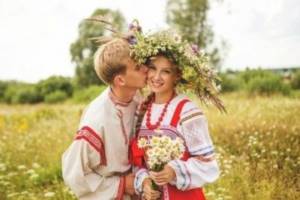
This day was celebrated without alcohol, fights, drunkenness and other indecent behavior. Lubomir is, first of all, a celebration of the soul, and only then of the body. A richly laid table was a secondary task. The tradition of wedding rings is an ancient and complex ritual. They have been preparing for engagement since adolescence. When a boy or girl turned twelve years old, they began to wear a silver ring. It was believed that this metal was sacred and capable of absorbing the positive energy of the owner. At the moment of engagement, the bride and groom exchanged these rings. They had to be worn closer to the heart - on the neck.
With these rings, the couple had to spend from 16 to 40 days, soaking in each other’s energy.
On the wedding day, the bride and groom put other rings on each other's ring fingers of their right hands. Silver ones were returned to the owner and worn on the ring finger of the left hand. This ritual closed the spiritual circle between the newlyweds.
There was no ransom in a Slavic wedding . This is due to the fact that the holiday is spiritual, there could be no talk of any money. On the eve of the wedding, fights were organized between the groom and the male relatives of the bride (father and brothers). This demonstrated the ability of the future spouse to protect his family. Another test option is hunting. The groom showed the bride's father how lucky and dexterous he was in this craft.
The bride had to undergo tests conducted by the female half of the groom. A woman was valued for her knowledge and skills in needlework, cooking, housekeeping, and it is good (but not necessary) for her to be able to sing and dance.
An obligatory part of the wedding day is round dances . The wedding round dance was especially important. It was held at the end of the celebration. Young people came closer to the reservoir and lit two fires on the shore: one for the boys, the other for the girls. The women's round dance was always performed in the direction of the sun; it was called posolon. The male round dance is in the opposite direction, that is, anti-salt.
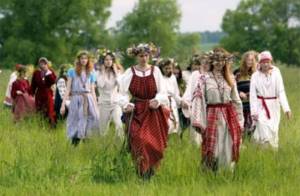
The fires were so close that the participants in the round dance touched each other's backs. When the sign was given, the round dances stopped and those whose backs touched left the circle. Then, the movement continued. Thus, there were nine pairs. They stood with their backs to each other and pronounced the name of the three worlds (Real, Prav, Nav), then turned their heads to the side. If their direction coincided, then this meant a spiritual connection between people.
The ritual did not mean that these boys and girls had to get married. This was a hint that it was necessary to take a closer look at each other.
Pre-wedding preparation
The process of preparing for the wedding day was laid out in stages and had a strict sequence:
- Matchmaking . Late in the evening, the groom and his matchmakers went to the bride's house. The timing was not chosen casually; if the groom is refused, no one will know about it. Men acted as matchmakers; they were the first to enter the house, treat the owners to bread and start a conversation. Then the bride and groom were called. The girl was asked her opinion, the parents, in turn, looked closely at their future son-in-law.
- Bride . Tests were arranged for the groom, and the girl came to his parents’ house and showed there her ability to manage a household.
- Engagement . The ceremony took place in the bride's house, and relatives from both sides gathered there. In addition to exchanging rings, the newlyweds had their hands tied with a towel. After the engagement, it was no longer possible to cancel the wedding and change your mind.
- Baking a loaf . The action took place in the bride's house. All married female relatives were convened; there had to be an odd number of them. They not only baked bread, but also had fun and sang songs.
- Bachelorette party and gala evening . In other words, farewell evening. That evening they wove wedding wreaths, danced, gave each other small gifts and sang.
Day of celebration
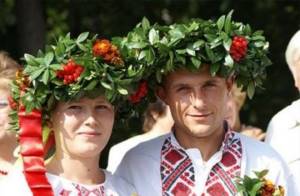
The wedding day was an even brighter day, it took place according to the following scenario:
- Dressing the bride and groom . The bride's dress must be full length and long sleeves, her head covered with a scarf. The color of clothing for both newlyweds is white, with an abundance of embroidered elements.
- Sending the groom out . He went to the bride's house, remaining there until the end of the day.
- Requests . The horses or cart were festively decorated, the young people visited the guests and invited them to the holiday.
- Posad . This is the main part, during which the marriage was concluded.
- Wedding . It was not enough to marry; the union had to be sanctified by the church and accepted by God.
- Coverage . This part completed the wedding celebration. A ritual was performed with the girl: they braided her hair (or cut it off completely), and covered her head with a headdress. We divided the wedding loaf among all the guests. These were the last actions in her home, after which her husband took her to his place.
- Transportation of dowry . It included not only clothing and other household supplies, but also money, plots of land and livestock.
Here you can see a photo of a Slavic wedding.
Slavic wedding
Wedding
— In ancient times, every person recognized himself, first of all, as a member of a certain clan.
Children belonged to the clan of their parents, but when a girl daughter got married, she passed into her husband’s clan. (This is why they “get married” - in the sense, they leave their clan, leave it.) The girl had to “die” in her previous clan and be “born again” in another, already a married, “husband” woman. These are the complex transformations that took place with the bride. Hence the increased attention to it, which we now see at weddings, and the custom of taking the husband’s surname, because the surname is a sign of the family. Hence the custom that has been preserved in some places to call the husband’s parents “mom” and “dad”, which, by the way, is often highly valued by older people, although they cannot really explain where this custom came from. “Joined the family” - and that’s it! Source - Esoterics.
Living Knowledge Now it is clear to us why the groom always tries to carry the bride over the threshold of his house in his arms: after all, the threshold is the border of the worlds, and the bride, previously a “stranger” in this world, must turn into “his own”...
What about the white dress? Sometimes you hear that it symbolizes the purity and modesty of the bride, but this is wrong. In fact, white is the color of mourning. Yes exactly. Black appeared in this capacity relatively recently. White, according to historians and psychologists, has been for humanity since ancient times the color of the Past, the color of Memory and Oblivion. From time immemorial, such importance was attached to it in Rus'. And the other - mourning wedding color was red, black, as it was also called. It has long been included in the attire of brides. There is even a folk song: “Don’t sew me, mother, a red sundress” - the song of a daughter who does not want to leave her home to strangers - to get married. So, a white (or red-white) dress is a “mournful” dress of a girl who “died” for her former family.
Now about the veil. Until recently, this word simply meant “scarf.” Not the current transparent muslin, but a real thick scarf, which was used to tightly cover the bride’s face. After all, from the moment she agreed to the marriage, she was considered “dead,” and the inhabitants of the World of the Dead, as a rule, are invisible to the living. And vice versa. It is no coincidence that the famous phrase from “Viy” by N.V. Gogol: “Lift my eyelids: I don’t see!” So no one could see the bride, and violation of the ban led to all sorts of misfortunes and even untimely death, because in this case the border was violated and the Dead World “broke through” into ours, threatening unpredictable consequences... For the same reason, the young people took each other’s hands exclusively through a scarf, and also did not eat or drink (at least the bride) throughout the wedding: after all, at that moment they were “in different worlds”, and only people belonging to the same family can touch each other, and especially eat together to the world, moreover, to one group, only “their own”.
Nowadays, young people are also not recommended to diligently treat themselves at their own wedding, much less drink intoxicating drinks, but for a completely different reason. They should soon become a Mother and... Father, can drunken spouses have full-fledged children?
It is worth mentioning another interesting custom related to the sharing of food between the bride and groom. In the old days in Rus' they said: “Don’t marry those with whom you eat together.” It would seem that what’s wrong if a guy and a girl work together or hunt and eat from the same bowl, like brother and sister? That's right - like brother and sister. (eating together made people “relatives.” And marriages between relatives were not encouraged - again in the interests of offspring...
...At the Russian wedding, many songs were sung, most of them sad. The bride's heavy veil gradually swelled with sincere tears, even if the girl was marrying her beloved. And the point here is not the difficulties of living married in the old days, or rather, not only them. The bride left her clan and moved to another. Consequently, she left the patron spirits of the previous kind and entrusted herself to new ones. But there is no need to offend and anger the past, or look ungrateful. So the girl cried, listening to plaintive songs and trying with all her might to show her devotion to her parental home, her former relatives and her supernatural patrons - deceased ancestors, and in even more distant times - a totem, a mythical animal progenitor...
This is the depth of historical memory that only one custom reveals to us, the origins of which, moreover, few people know.
Now let’s remember Russian (and not only Russian) fairy tales, in which the sympathy of the narrator, and of all good people, is always on the side of the younger sister. She is smart, beautiful, and a needlewoman, while the older ones (usually two) are stupid, grumpy and ugly...
This is due to an ancient custom: until the older sisters were married off, the younger sisters were not allowed not only to accept matchmakers, but even to dress beautifully and go to a round dance or to get-togethers - also a kind of exhibition of brides. What if the older sisters, as in “Cinderella” or “The Scarlet Flower,” are evil and lazy, whom no one will marry? Here is the source of family quarrels and conflicts. And the younger sister does not have to be a “stepdaughter” at all; this motive appeared later, when the true reason began to be forgotten. The younger sister already found herself at the beck and call of the elders and walked around in cast-offs - especially if she was really more beautiful: it’s scary to think that suddenly someone will pay attention to her and woo her, bypassing the elders! If this happened, the older sisters would be forever disgraced; they would almost certainly never be married again. So Cinderella doesn't just triumph at the end. She truly commits “terrible revenge”!..
We should once again remember about the “braid - a girl’s beauty.” Since pagan times, the custom has been preserved to say goodbye to her forever and to braid the young wife two braids instead of one, moreover, laying the strands one under the other, and not on top. If the girl ran away with her beloved against the will of her parents (this is the kind of marriage that was called “marriage against the will”; the will meant exclusively the parents, and not the bride herself, (as is sometimes thought), the young husband cut off the girl’s precious braid and presented it to the newly-made father-in-law and mother-in-law, along with a ransom for kidnapping the girl. And in any case, a married woman had to cover her hair with a headdress or scarf (so that the “power” contained in it would not harm the new family). headdress meant to cause witchcraft damage to her family, insult her herself and get into serious trouble - a fine, if not blood feud. And the wedding ransom was called “veno” in Ancient Rus', and this word is related to the words “wreath” and “crown” —- girl's headdress...
I still need to say a few words on a delicate topic. For some reason, it is believed that in old Russia and “even more so” in Ancient Rus', a girl who gave birth to a child before marriage was considered irreparably disgraced. There are countless “historical” films and books where unfortunate young mothers are haunted by terrible misfortunes: they drown themselves, hang themselves, go crazy, their suitors abandon them, their parents curse them, they drive them out of the house...
Well, in some areas of Russia, maiden chastity was indeed very strictly monitored. But just as often, everything looked decidedly the opposite. Premarital children were by no means a hindrance to weddings—far from it! It was their mothers who were considered “the first brides in the village.” After all, what has been the main requirement for a woman since ancient times? So that she can bear and give birth to healthy, strong children. So the guys vied with each other to woo young mothers who had already proven their worth as women. When a girl got married, who knows if she got caught?..
This would be the case, particularly in the Russian North, among the Old Believers. Sometimes they even had premarital children on purpose, so that they would be more likely to get matched, so as not to remain unmarried.
And if the father of a premarital child was a noble warrior, a boyar, the prince himself (it is over such situations that we most often cry in the movies), the young mother was not only not cursed, she was carried in the arms of both her family and the groom’s family: happiness in lured the house! Everyone knew that the warriors, especially the noble leaders, were blessed by the grace of the Gods. In Ancient Rus', a slave who gave birth to a child from her owner was freed from slavery...
And this is how they still try to celebrate a wedding in existing pagan communities:
According to Slavic custom, the groom abducted the bride at the games, having previously agreed with her on the abduction: “I went to the games... and that wife was taken away by myself, whoever had an affair with her: the name had two and three wives.” Then the groom gave the bride's father a vein.
The wedding took place in the afternoon, towards evening. The groom's mother prepared the wedding bed: first she laid sheaves (21 in number), a feather bed and a blanket on top, and threw a marten fur coat or marten skin (or weasel) on top. Tubs with honey, barley, wheat, and rye were placed near the bed. Having prepared everything, the future mother-in-law walked around the bed with a rowan branch in her hand.
Before the wedding, the groom's place was taken by a younger brother or teenager, from whom the groom had to buy a place next to the bride. After the ransom, the bride and groom, holding a lighted candle in their hands, walked to the temple. The dancers walked ahead of them, and behind them they carried a cow, on which lay pieces of silver. Behind the young ones, the young man carried a bowl of hops, grain and silver. The matchmaker showered the bride and groom from the bowl. The guests wished the bride as many children as there were hairs in a sheepskin coat. After such wishes, the matchmaker also graciously showered the guests.
The priest performed the wedding, took the bride by the hand, handed it over to the groom and ordered them to kiss. The husband covered his wife with the hem of his dress or cloak, as a sign of patronage and protection, after which the priest gave them a bowl of honey. Standing before the altar, the husband and wife drank from the cup three times in turn. The groom splashed the remaining honey on the altar and threw the cup at his feet, saying:
“Let those who sow discord among us be trampled underfoot.”
The one who first stepped foot on the cup, according to legend, became the head of the family.
On the way home, the newlyweds walked tightly clinging to each other, and the guests certainly tugged at their sleeves, trying to separate them. After such a simple test, everyone sat down at the table and began to feast. Everyone except the young ones, who, although there was fried chicken in front of them, ate it only at the end of the feast. The newlyweds were not allowed to drink or eat during the wedding feast. At the height of the fun, the young people went into the vestibule, where the marriage bed had been prepared in advance.
Goy, goy, Svarog, take me through the threshold. Goy, goy, Svarog Lada, Lada has a pie.
Under such parting words, the young people, taking a ritual cow wrapped in a towel and a chicken, locked themselves in the entryway. The groom's friend walked at the door with a drawn sword, guarding the peace of the newlyweds.
Trample the marten's coat! Push each other! Have a good night's sleep! Have fun getting up!
After such wishes, the guests retired to the house, but after a while they were sent to inquire about “health.” If the groom answered that he was in “good health,” then “good” had happened. “Having stood up cheerfully,” the young people began to eat. Having taken the chicken, the newlywed had to break off the leg and wing, and then throw them back over his shoulder. Having tasted chicken and cow, the young people joined the guests and the fun continued.
The groom's groomsman read the blessings:
To guests:
Yes, good people! Amorous guests Invited and not invited, Mustachioed and bearded, Single and unmarried. At the gate of the gatekeeper, At the door of the gatekeeper. Walking on the floor, standing in the middle. From the corner along the bench Along the curve, along the bench! Bless!
Well done:
Young, young! Good gaits, Mustel fur coats, Sable fluff, With glazed eyes, With oiled heads, Golden cocottes, Silver earrings, Fathers' daughters, Well done wives! Thank you!
To the girls:
Red maidens, Pastry craftswomen, Scratched heads, Shoed shins, Crochet harlots, Sour cream was removed, Kokurks were kneaded, They were buried under arrest, Shepherds were given gifts. Bless!
To the guys:
Yes! Little guys, pig dicks! Crooked stomachs, Honeysuckle legs, Gastrointestinal faces, Look like an ass. Bless!
After such blessings, the feast flared up with renewed vigor. The feast ended with games, after which those who could still walk went home.
It is necessary to make some notes on the ritual: The groom at the wedding wears white, the bride wears red. Almost the entire wedding, the groom holds the bride’s hand, emphasizing his affection for her.
Before sharing the marriage bed with her young husband, the wife took off her husband’s shoes. There was a coin in one boot, and if it came across in the first boot, then a happy life was expected.
Rating: 5.49
(Views: 38781)
Read the section Rodnovers, Slavs on the esoteric portal naturalworld.guru.
Stylistics, symbolism and attributes
In order for the wedding day to go according to tradition, the following attributes must be present::
- Rushnik . This is an embroidered piece of fabric in the shape of a long towel. It was the protection of the family and clan, it was passed on from one generation to another. The towel was used to present a loaf or other treat. It was forbidden to step on the towel, as the family would lose the protection of the spirits and doom itself and its descendants to misfortune.
- Homespun towel . It was used to bind the hands of young people during betrothal. Afterwards, the towel was given as a dowry to the bride.
- Loaf . Sweet bread beautifully decorated with curls, flowers, braids. The richer the loaf, the happier and more prosperous the life of the young people was. With the help of the loaf, a ritual of honor to Mother Earth and Father Sky was performed.
- Rings . With their shape they symbolized the sun, which was held in high esteem by the Slavs, then still pagans. The circle is a symbol of harmony, unity and fidelity.
- Wreath of flowers . It was worn by both the bride and groom. A wreath is a symbol of love and sun rays hidden in herbs and flowers.
- Wedding party . An embroidered amulet signifying both the creative and destructive principles of the sun. It means the interweaving of two families and serves as a talisman for a new family. The wedding dress was given by the parents after the wedding ceremony.
Slavic wedding ceremony
One of the wedding ceremonies was the wedding. It personified the divine blessing of the young for the union. A prerequisite for a wedding was the purity of the bride (virginity). During this ceremony, the newlyweds put wreaths on each other (hence the name - wedding). The wedding took place in a church (usually Svarog or Lada, because they are the patrons of the family).
The most favorable days for the ceremony were Friday, Saturday and Sunday. The future husband and wife were preparing two rings, two towels, two candles, two clay mugs, and a pot of honey for the wedding. The ritual was performed by the Magi. Before the start, it was necessary to line up all the guests and important participants according to certain rules. By the way, the bride and groom were called princess and princes, respectively. Why were pre-prepared attributes necessary?
The newlyweds were also sprinkled with grain. This was done so that many children would be born into the family. Then the young people jumped over the fire three times for purification and blessing by Svarog. The Slavic wedding ceremony also involved passing through some kind of body of water (a river or even a stream). This symbolized the beginning of a new life, overcoming all difficulties together. And in general, customs that are in one way or another connected with natural elements (water, fire) are very characteristic of all Slavic rituals and traditions.
Conclusion
This is how our ancestors spent their weddings: fun and very interesting. For them, the wedding ceremony was one of the most important in the life of every person. They carefully prepared for it. Interestingly, many traditions have been preserved to this day. For example, a bachelorette party, breaking mugs (glasses) for good luck, sprinkling the newlyweds with grain or cereal, bride price. Wedding has also been preserved, but today within the framework of Christianity, not paganism. For the Slavs, a wedding was an event that happened only once in a lifetime. After all, the union was concluded not only on earth, but also in heaven.
How to organize such an event in the old Russian style these days?
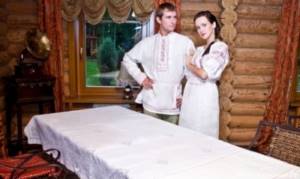
Preparation is an important part of organizing a modern Slavic wedding:
- Place of celebration . It is better to choose a lawn, not far from a pond. Another option is a country house or estate in the Russian style.
- Invitations . These can be postcards with folk patterns, decorated with flowers and twigs.
- Menu . There should be dishes of Russian cuisine on the table. Their variety is enormous: cabbage soup, fish soup, pies, pancakes, stewed meat, baked fish, pickles, mushrooms, herring. Instead of a cake, it is better to serve a large berry pie.
- Alcohol . His presence at a Russian wedding is undesirable. If you cannot do without it, then it is better to give preference to Russian drinks: kvass, mead, herbal and berry tinctures.
- Cortege . The ideal option is horse-drawn carts. If this is not possible, then the cars can be decorated with ribbons with folk ornaments and wildflowers.
- The image of the bride . For a girl, it is better to choose a floor-length red sundress with a white, embroidered blouse. A more familiar option is a white wedding dress, trimmed with embroidery in a folk style. On the head is a scarf or a wreath of flowers. The traditional hairstyle is a braid.
- Image of the groom . Consists of trousers, white, embroidered shirt, wide belt and boots.
The celebration scenario is traditional and differs only in nuances:
- Ransom . It is better to refuse money for the bride and ask the groom to show his resourcefulness, dexterity and, of course, love. These can be tasks with dances, songs, ditties and confessions.
- Registration . The best option is outdoors, in nature, not far from a birch grove.
- Wedding . This stage is an obligatory part of a Russian wedding. It takes place according to church traditions.
- Photoshoot . Beautiful photos are taken in a field, a birch grove, on the shore of a lake. Accessories include: flower wreaths, folk-style scarves, wicker baskets, a samovar and a loaf of bread.
- Festive feast . The newlyweds are greeted with bread and salt and seated at a laid table. For entertainment, it is better to choose round dances, dances, harmless competitions, and at the end of the evening - lighting a fire.
A well-planned wedding in the traditional Russian style is a celebration that will be remembered not only by the guests, but also by the newlyweds themselves.
Wedding traditions and rituals of the ancient Slavs
The ancient name of the wedding is Lubomir . This day was celebrated without alcohol, fights, drunkenness and other indecent behavior. Lubomir is, first of all, a celebration of the soul, and only then of the body. A richly laid table was a secondary task.
The tradition of wedding rings is an ancient and complex ritual. They have been preparing for engagement since adolescence. When a boy or girl turned twelve years old, they began to wear a silver ring. It was believed that this metal was sacred and capable of absorbing the positive energy of the owner. At the moment of engagement, the bride and groom exchanged these rings. They had to be worn closer to the heart - on the neck.
With these rings, the couple had to spend from 16 to 40 days, soaking in each other’s energy.
On the wedding day, the bride and groom put other rings on each other's ring fingers of their right hands. Silver ones were returned to the owner and worn on the ring finger of the left hand. This ritual closed the spiritual circle between the newlyweds.
There was no ransom in a Slavic wedding . This is due to the fact that the holiday is spiritual, there could be no talk of any money. On the eve of the wedding, fights were organized between the groom and the male relatives of the bride (father and brothers). This demonstrated the ability of the future spouse to protect his family. Another test option is hunting. The groom showed the bride's father how lucky and dexterous he was in this craft.
The bride had to undergo tests conducted by the female half of the groom. A woman was valued for her knowledge and skills in needlework, cooking, housekeeping, and it is good (but not necessary) for her to be able to sing and dance.
An obligatory part of the wedding day is round dances . The wedding round dance was especially important. It was held at the end of the celebration. Young people came closer to the reservoir and lit two fires on the shore: one for the boys, the other for the girls. The women's round dance was always performed in the direction of the sun; it was called posolon. The male round dance is in the opposite direction, that is, anti-salt.
The fires were so close that the participants in the round dance touched each other's backs. When the sign was given, the round dances stopped and those whose backs touched left the circle. Then, the movement continued. Thus, there were nine pairs. They stood with their backs to each other and pronounced the name of the three worlds (Real, Prav, Nav), then turned their heads to the side. If their direction coincided, then this meant a spiritual connection between people.
The ritual did not mean that these boys and girls had to get married. This was a hint that it was necessary to take a closer look at each other.
Wedding rituals - water and fire
The wedding ceremony includes the obligatory crossing of flowing water - a river or even a stream. Why? Because living water, according to Slavic mythology, separates the worlds, creates a transition between this place and that, and allows you to travel between worlds. The bride, groom and wedding train go between the worlds on a subtle level, the forces of the Rule seem to be testing and weighing at this hour feelings, intentions, the correctness of creating a new family, a new future for both families. This is the time when the past, present and future are woven into a new ball, from which the destinies of the next generations will be woven. This is why the bride must be open to the Gods, even if it means being open to the forces of Chaos. This is the deep meaning that Slavic wedding traditions carry.
Here, finally, is the temple, the sorcerer and the sacred fire. The wedding ceremony must receive permission from the Gods.
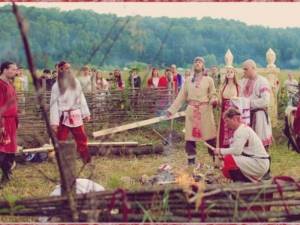
Prayer to the Gods for permission to marry. Veles circle
"Oh Gods! Will you accept the demand, will you agree with the union of these clans?
- everyone, trembling, awaits the answer to this question from the sorcerer.
If the answer is “No”
, the wedding will not happen now!
If: “Yes
,” then the sacred fire, around which the young people will walk around three times holding hands, will unite the clans in an eternal union. The Guardian Churs will gently cover the young wife with their protection. The newlyweds are married in heaven, the families are united! Hooray! It's finished!
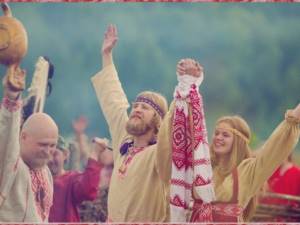
Veles Circle Now you can rest, anchored in the manifest world for the duration of the wedding feast, and then soar again to the heights of the Spirit on the wedding night, when the Gods open their world to lovers.
Stylistics, symbolism and attributes
In order for the wedding day to go according to tradition, the following attributes must be present::
- Rushnik . This is an embroidered piece of fabric in the shape of a long towel. It was the protection of the family and clan, it was passed on from one generation to another. The towel was used to present a loaf or other treat. It was forbidden to step on the towel, as the family would lose the protection of the spirits and doom itself and its descendants to misfortune.
- Homespun towel . It was used to bind the hands of young people during betrothal. Afterwards, the towel was given as a dowry to the bride.
- Loaf . Sweet bread beautifully decorated with curls, flowers, braids. The richer the loaf, the happier and more prosperous the life of the young people was. With the help of the loaf, a ritual of honor to Mother Earth and Father Sky was performed.
- Rings . With their shape they symbolized the sun, which was held in high esteem by the Slavs, then still pagans. The circle is a symbol of harmony, unity and fidelity.
- Wreath of flowers . It was worn by both the bride and groom. A wreath is a symbol of love and sun rays hidden in herbs and flowers.
- Wedding party . An embroidered amulet signifying both the creative and destructive principles of the sun. It means the interweaving of two families and serves as a talisman for a new family. The wedding dress was given by the parents after the wedding ceremony.
How to organize such an event in the old Russian style these days?
Preparation is an important part of organizing a modern Slavic wedding:
- Place of celebration . It is better to choose a lawn, not far from a pond. Another option is a country house or estate in the Russian style.
- Invitations . These can be postcards with folk patterns, decorated with flowers and twigs.
- Menu . There should be dishes of Russian cuisine on the table. Their variety is enormous: cabbage soup, fish soup, pies, pancakes, stewed meat, baked fish, pickles, mushrooms, herring. Instead of a cake, it is better to serve a large berry pie.
- Alcohol . His presence at a Russian wedding is undesirable. If you cannot do without it, then it is better to give preference to Russian drinks: kvass, mead, herbal and berry tinctures.
- Cortege . The ideal option is horse-drawn carts. If this is not possible, then the cars can be decorated with ribbons with folk ornaments and wildflowers.
- The image of the bride . For a girl, it is better to choose a floor-length red sundress with a white, embroidered blouse. A more familiar option is a white wedding dress, trimmed with embroidery in a folk style. On the head is a scarf or a wreath of flowers. The traditional hairstyle is a braid.
- Image of the groom . Consists of trousers, white, embroidered shirt, wide belt and boots.
The celebration scenario is traditional and differs only in nuances:
- Ransom . It is better to refuse money for the bride and ask the groom to show his resourcefulness, dexterity and, of course, love. These can be tasks with dances, songs, ditties and confessions.
- Registration . The best option is outdoors, in nature, not far from a birch grove.
- Wedding . This stage is an obligatory part of a Russian wedding. It takes place according to church traditions.
- Photoshoot . Beautiful photos are taken in a field, a birch grove, on the shore of a lake. Accessories include: flower wreaths, folk-style scarves, wicker baskets, a samovar and a loaf of bread.
- Festive feast . The newlyweds are greeted with bread and salt and seated at a laid table. For entertainment, it is better to choose round dances, dances, harmless competitions, and at the end of the evening - lighting a fire.
A well-planned wedding in the traditional Russian style is a celebration that will be remembered not only by the guests, but also by the newlyweds themselves.




